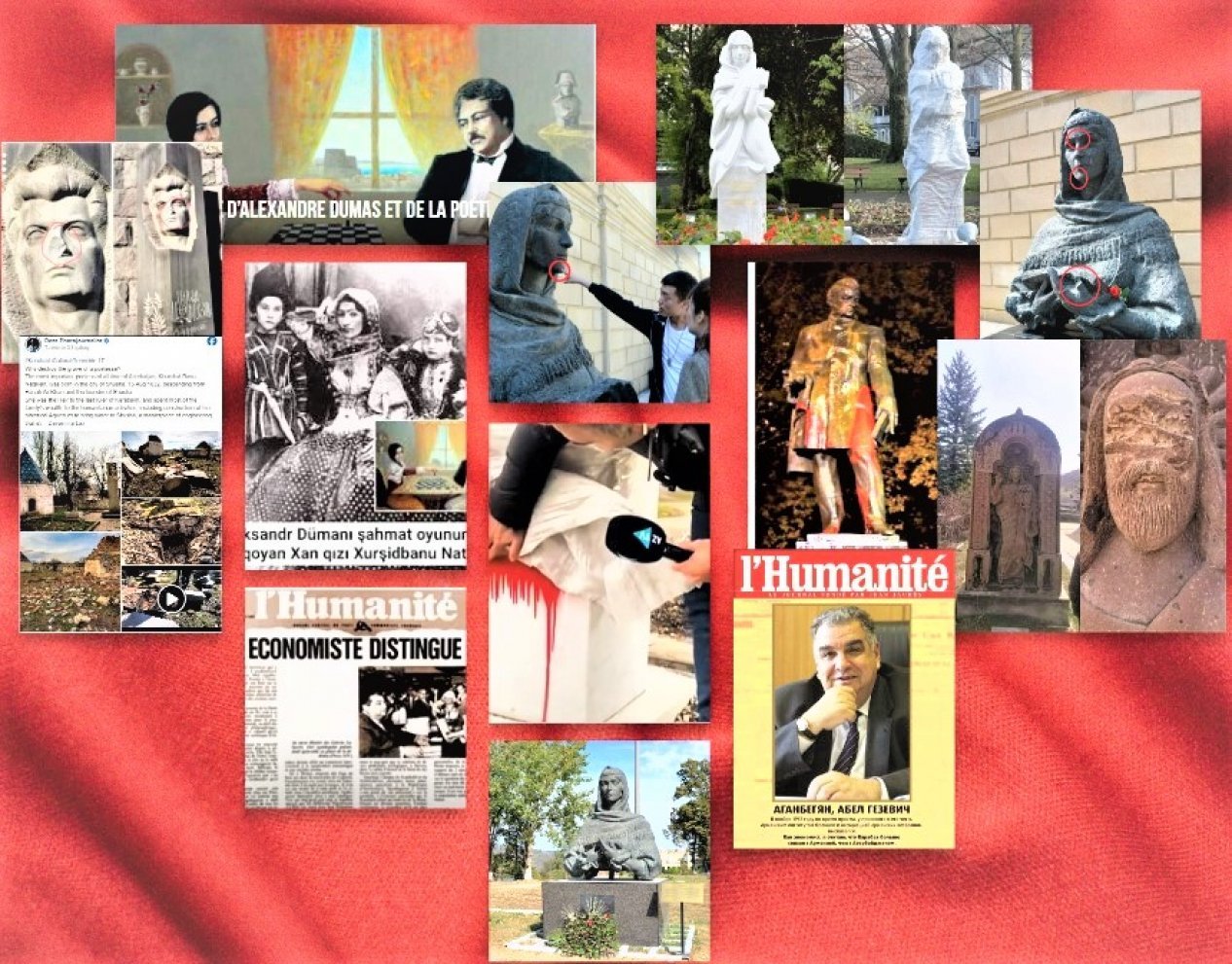
“As you know, the statue of Khurshidbanu Natavan [Azerbaijani poet and philanthropist] has been vandalized. It was doused with red liquid and its nose was broken. The service responsible for this area of the city covered the monument to protect it,” Deputy Director on Attractiveness of the mayor’s office of the French city of Evian-les-Bains Christelle Auclere told AZERTAC.
Asked whether there had been any investigation into the act of vandalism, Christelle Auclere said that she was not in a position to comment, adding that there is no video surveillance system there, which makes it difficult to identify the perpetrators of the vandalism.
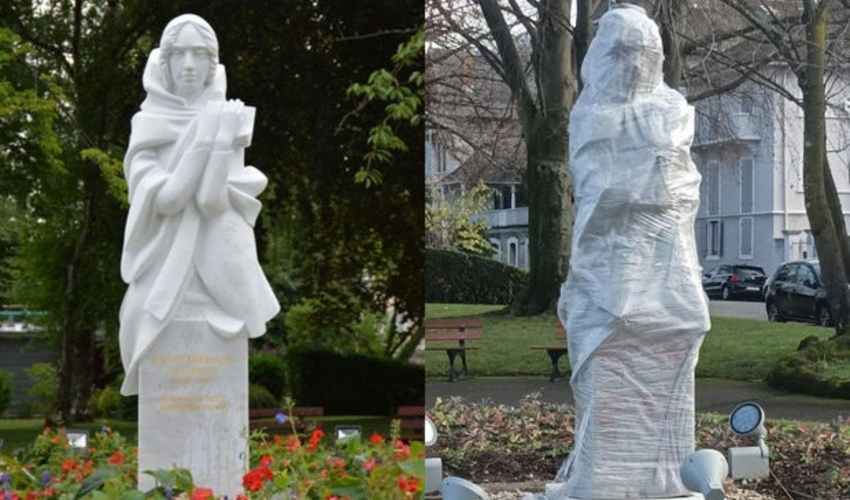
Faktyoxla Lab. puts forward own version of the identity of the perpetrators of this incident.
Fragment 1. A detail caught our attention during the filming of the Azerbaijani television staff around the monument. In these shots, the word "Azerbaijan" engraved on the monument of the poetess is doused with red liquid.

This detail reminded us of the act of vandalism committed against another monument in Yerevan, the capital of Armenia, in 2010.
Thus, on October 20, 2010, in the center of Yerevan (Circular Boulevard), the "monument erected in honor of the Holocaust victims" was vandalized in the same form. The memorial consists of two stone slabs and a pomegranate connecting them. "Live and remember" is written on the plaques in Armenian and Hebrew languages.
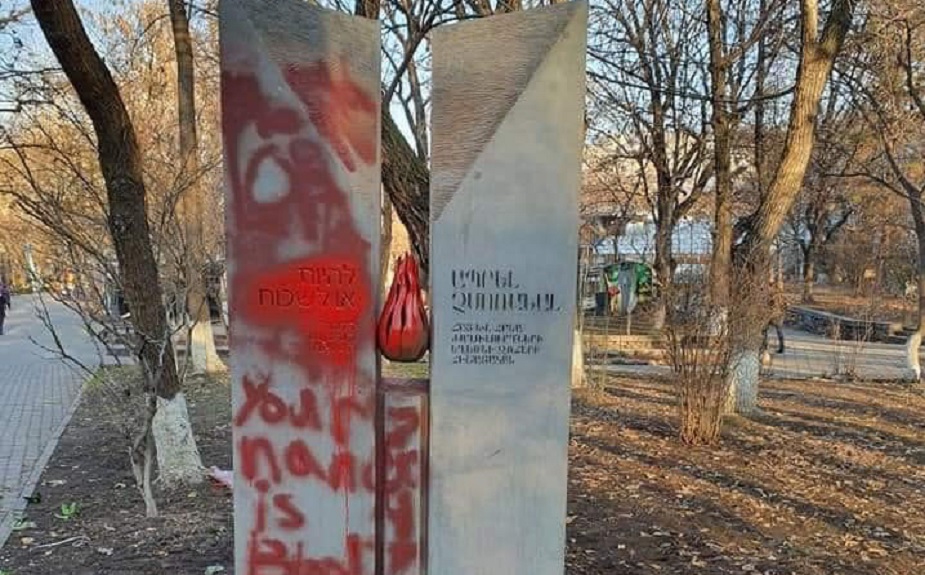
A report prepared by journalist Nelly Madatian (RFI) says that there was a pedestal dedicated to the memory of Holocaust victims at the place of this monument and it was repeatedly attacked. "The first vandal attack was committed in September 2004 - the last day of the Jewish New Year. At that time, unknown vandals painted a cross on the pedestal with white paint and wrote the "devil's number" 666. In the following months, the pedestal was moved at least four times," the Armenian journalist added, adding that this time the part of the stone tablet written in Hebrew read "Death to the Jews!" in Armenian. (in fact, the name of the Jewish people is expressed more insultingly - ed.).

Fragment 2. The painting of monuments with liquids is not the first and only case recorded in Armenia. In 2019, the statue of Russian playwright and diplomat Alexander Griboyedov was also vandalized.

The perpetrator of the act was Shagen Harutyunyan, the chairman of the radical Armenian "Tsegakron" party, the son of Shant Harutyunyan, who was a political prisoner. Newsarmenia.am wrote that Shagen Harutyunyan shared the photo of the act of vandalism he committed on his Facebook profile and wrote, "In response to the painting of Nzhdeh’s plaque in Russia, I painted the monument of the ambassador of the Russian Empire, writer Griboyedov in red." Opening a live broadcast, he said that "Nzhdeh’s "Tsegakron" ideology is not just words for him."

We won’t give detailed information about Nzhdeh’s identity, it is possible to get enough information about the bearer of fascism ideas.
Let's pay attention to other facts similar to the desecration of Natavan’s monument.
Fragment 3. We noted that the official of Evian-les-Bains city hall said in an interview to AZERTAC that "the nose of the statue was broken." This detail also reminded us of two other incidents against monuments in Armenia.
One of them is the desecration of the monument of Jesus Christ in April 2022. The material authored by Sputnik-Armenia correspondent Lilit Harutyunyan states that in April, an act of vandalism was committed against the monument of Jesus Christ in two separate cities. On April 23, they broke the leg and toes of the basalt statue of the Savior on David-Bek Street in Yerevan.
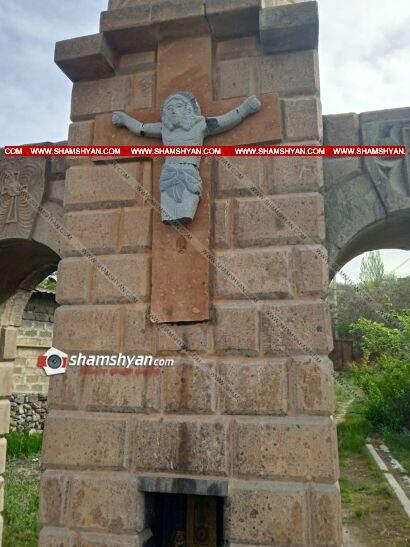
In another case, in the yard of the "Tukh Manuk" church in the village of Jrarat, Kotayk region, they tore off the nose of the monument of Jesus Christ made of red tuff, and broke the fingers of his right hand.

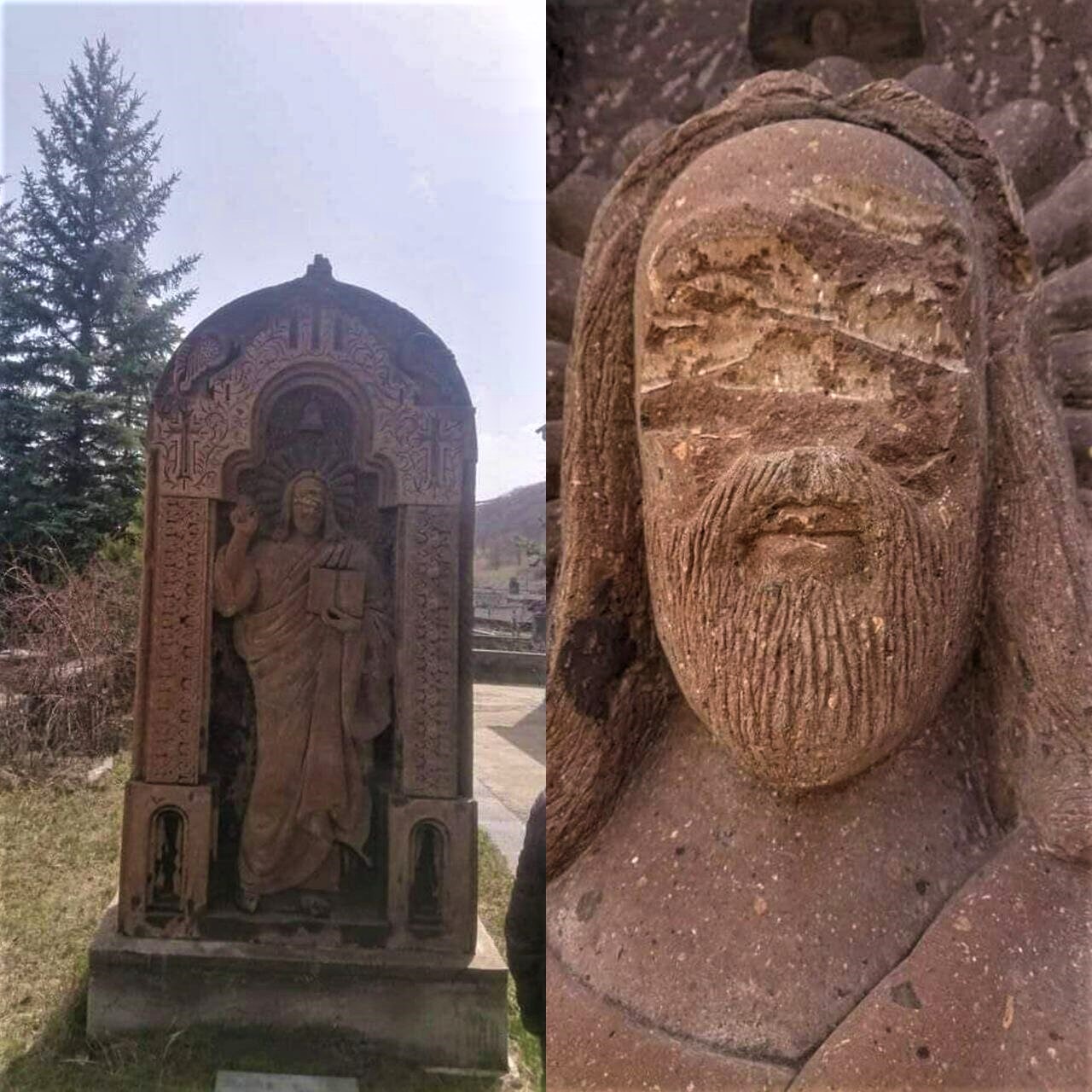
Fragment 5. A similar event was recorded on April 14, 2022 in the city of Yerevan. This time, Armenians committed an act of vandalism against the monument of the "hero" Leonid Azgaldyan, who committed cruelty and brutality against Azerbaijanis in Karabakh, and broke the nose of his bust.

If we look at the statistics, we will see that in 2021, six criminal cases were initiated under Article 260 (vandalism against monuments) of the Criminal Code, and one of them was solved. Since January 2022, two similar cases have occurred. At the same time, in 2021, 30 cases were registered under Article 264 ("Destruction or damage to historical and cultural monuments"), of which only two were solved. In January 2022, four cases occurred.
Fragment 6. During the visit of Armenian President Serzh Sarkissian to France in 2016 (on the day he went to Waterloo), the monument of Khurshidbanu Natavan erected in this city was vandalized.
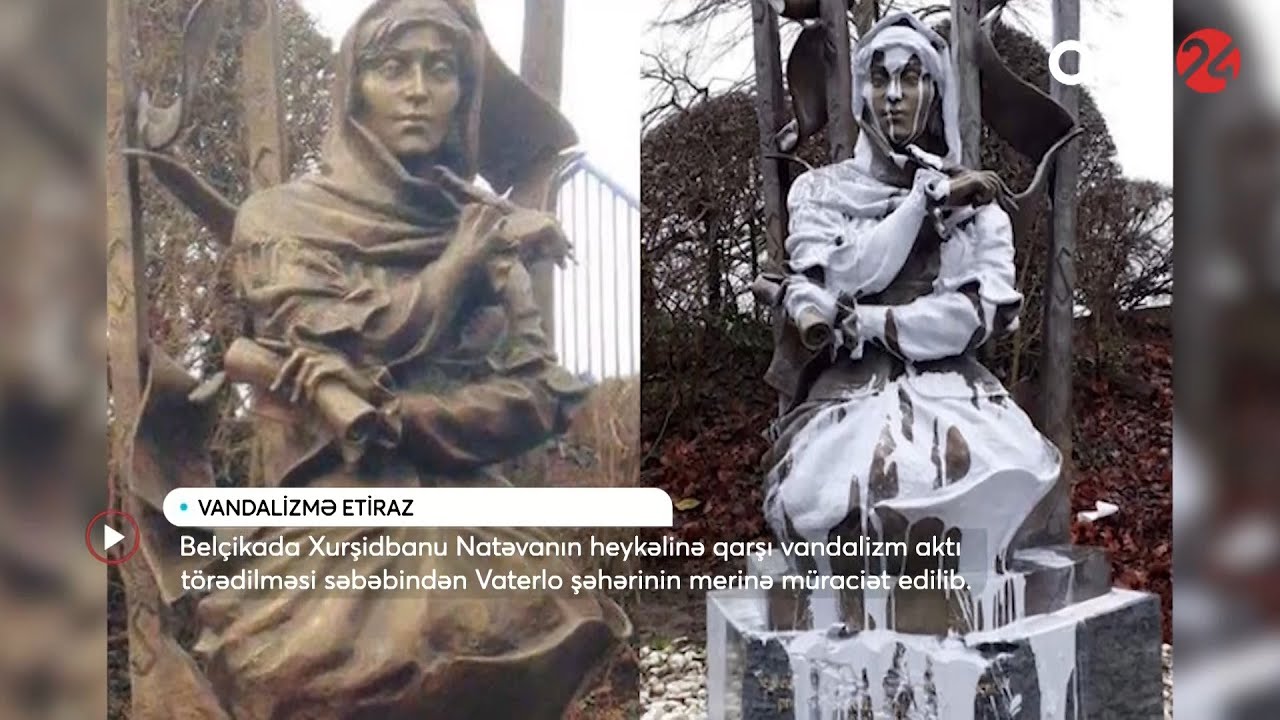
Khurshidbanu Natavan is known throughout the East and the Islamic world as a prominent poet, artist, educator and philanthropist, a fighter for women's freedom and women's rights. Her works have been declared state heritage in Azerbaijan. Natavan, mentioned in the works by the famous French writer Alexandre Dumas, is also considered representation of friendship between the peoples of Azerbaijan and France.
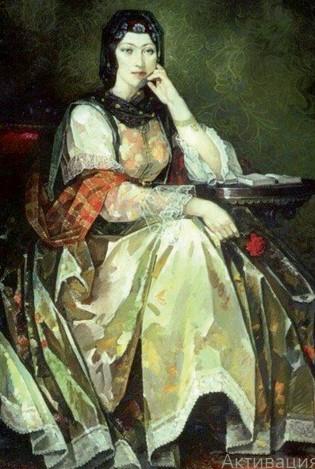
Natavan is the descendant of Panahali Khan, who founded the city of Shusha, the whole life and activities of the Khan's relative were closely connected with her native Shusha. She constantly worked for the improvement and development of the social and cultural environment of the city of Shusha, and gained fame for her humane nature, nobility, and compassion. After the occupation of the South Caucasus and Azerbaijan by the Red Army, the Nagorno-Karabakh Autonomous Oblast was established in the Karabakh region, where Armenians compactly live, and the ancient Azerbaijani city of Khankandi was renamed Stepanakert. The family of Khan's relative Natavan lived in that city. There are enough sources and facts that confirm this. (source)
After the territorial claims started by Armenia against Azerbaijan since 1988, the dark days of the Azerbaijanis, especially the residents of Karabakh and the regions bordering with Armenia, which is the occupying state, began. By the way, no matter how surprising it is, Armenia's territorial claims against Azerbaijan started with an interview with the French magazine Humanite by Abel Aganbegyan, who was the adviser on economic issues of the last president of the Soviet Union, Mikhail Gorbachev.
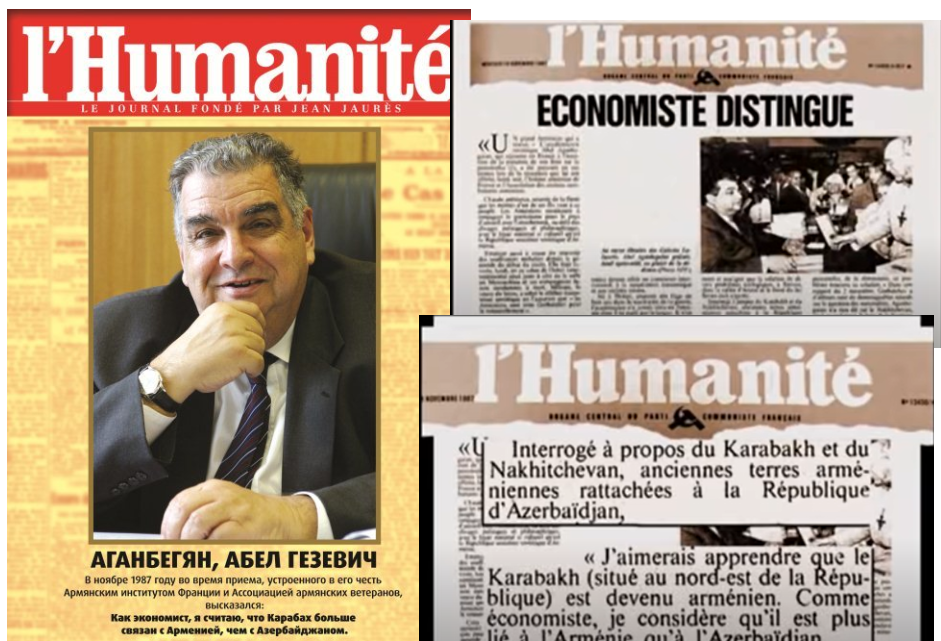
After that, on May 8, 1992, the ancient Azerbaijani city of Shusha, and on July 23, 1993, the city of Aghdam was occupied by the Armenian Armed Forces. In fact, all of Karabakh and seven other districts adjacent to the region were also occupied. We only mention Shusha and Aghdam because they are directly related to the topic. So, after the fall of Shusha city in 1992, Armenian terrorists and robbers started massive looting in the city. (Thomas De Waal, Black Garden: Armenia and Azerbaijan Through Peace and War. New York University Press. 2003)
The turn reached the bronze busts of the brilliant Azerbaijani composer Uzeyir Hajibayli, the author of the first opera in the East, Bulbul with a wonderful voice, and Khan's descendant Natavan, which have been placed in one of the prominent places of Shusha since 1982. After realizing that the material from which the monuments are made is valuable, the terrorists who shot the busts at first decided to take the monuments to Armenia and melt them down to sell them.
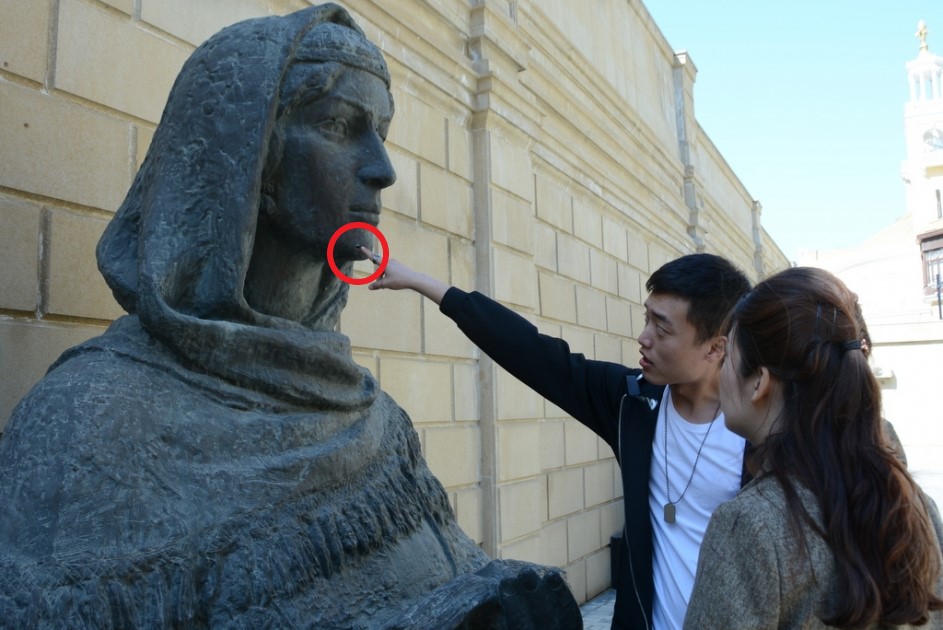
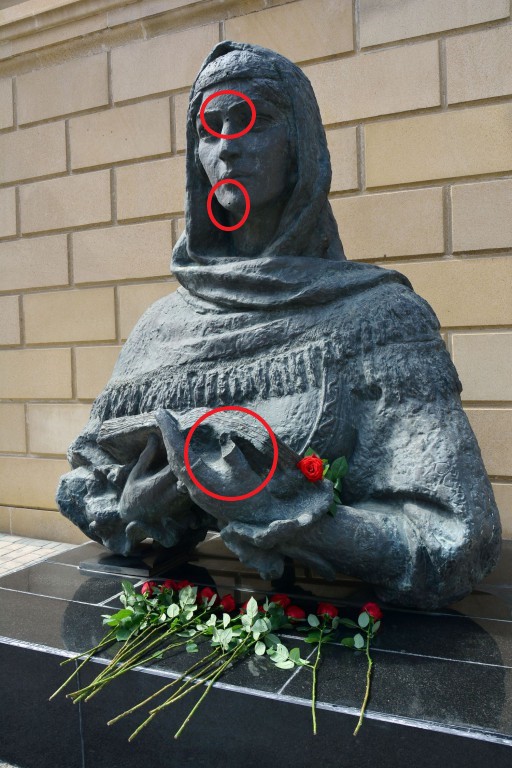
As a result of an accident, this issue became known to the Azerbaijani side, and as a result of negotiations with the Armenians (for a large amount of money, ed.), the busts were first brought to Tbilisi, the capital of Georgia, and from there to Baku. Currently, all three busts are back in their place - in the liberated city of Shusha.
The second point is related to the city of Aghdam. The city of Aghdam, which is called "the Hiroshima of the Caucasus", was a victim of Armenian vandalism during the occupation. In the city, not only private buildings and historical monuments were destroyed, but not a single stone was left standing. The famous photographer Reza Deghati, who visited there after the liberation from the occupation according to the 2020 agreement, revealed an incredible atrocity.
On his Facebook page, Deghati said that the ancient tomb and crypt that once existed in the city of Agdam were destroyed, and the most terrible thing was that the bones of Khurshidbanu Natavan were taken out of the grave: “The big shock was not to see how everything was destroyed deliberately, but to find out that her tomb was raided and even all her bones were taken away, probably by the same people who have been drinking water from the Aqueduct that she built! Who is afraid of a poetess?”
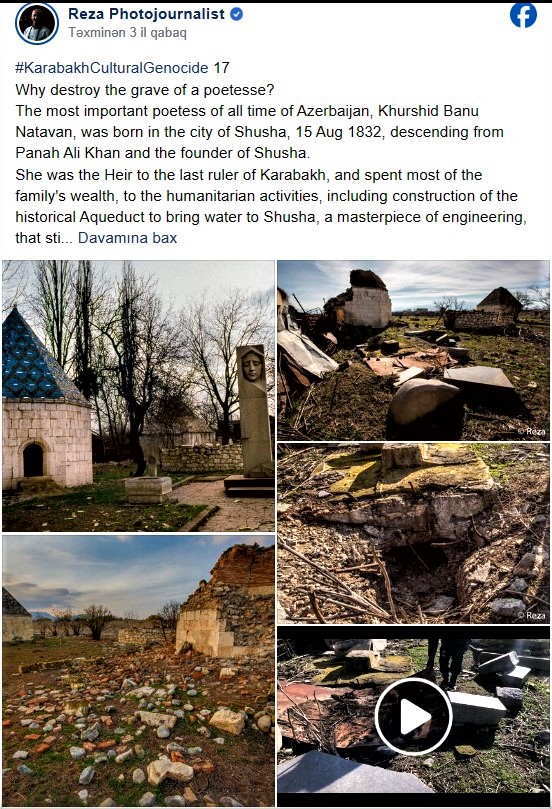
Deghati writes on his page: “In 1992 before the fall of town to Armenian forces I visited the cultural center and was amazed by the architecture and also the beauty of the statue that was on her tombstone. After the city was liberated, November 2020, I returned to the same place.” (video)
Previous state of Natavan’s grave:
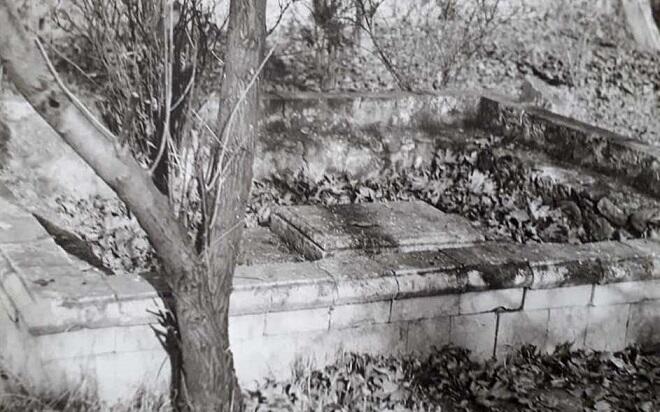
This is the state of the grave photographed by Reza Deghati after the occupation:
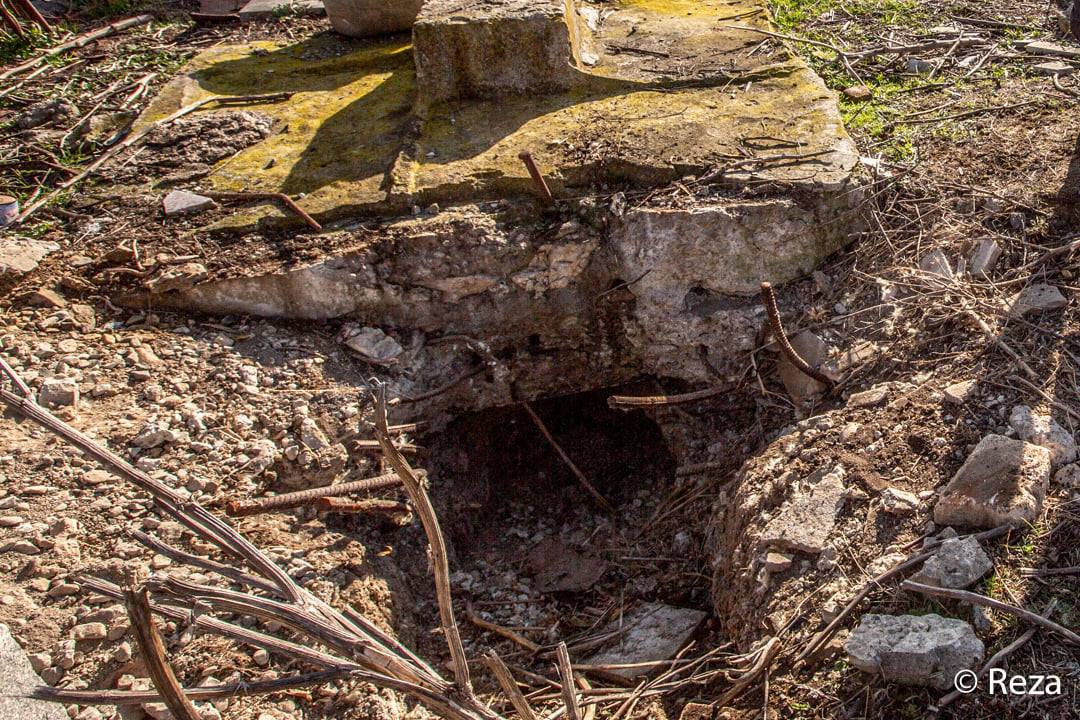
Head of the International and Public Relations Sector of the State Service for the Protection, Development and Restoration of Cultural Heritage under Azerbaijan’s Ministry of Culture Nurida Allahyarova emphasized that the territory of the building complex, where the palace of Panahali Khan, the founder of the Karabakh Khanate, is located in the city of Aghdam, is also the burial place of the Khan dynasty:
"Here were the tombs of Panahali Khan, who founded the Karabakh Khanate, and the rulers of the Khanate - Ibrahimkhalil Khan and his son Mehdigulu Khan, as well as Khurshidbanu Natavan, the daughter of Mehdigulu Khan. Other prominent people who were descendants of Karabakh khans were also buried in this cemetery. However, after the occupation of Aghdam city, the cemetery was also subjected to Armenian vandalism. "Armenian vandals completely destroyed the tomb of Ibrahimkhalil Khan and the monument of Khurshidbanu Natavan, the Heir of the last ruler of Karabakh, Mehdigulu Khan Javanshir," she said.
There is no information on whereabouts of the remains of Khan daughter's body.
Conclusion:
- The answer to all the doubts regarding the vandalism of the monument to the Azerbaijani poetess Khurshidbanu Natavan, known throughout the East and the Islamic world as a prominent poet, artist, educator and philanthropist, a fighter for women's freedom and women's rights, erected in 2017 in the city of Evian-les-Bains is Armenian fascism, racial-religious discrimination and vandalism!
- We do not see the need to talk in detail about why all these acts were committed against Khurshidbanu Natavan. The simplest reason is to take revenge on Khurshidbanu, who founded the city of Shusha and was the only successor of the generation that owned Khankandi, to erase her from history.




















